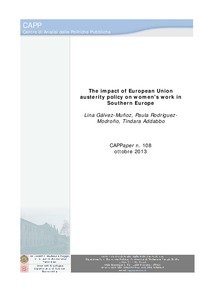The impact of European Union austerity policy on women's work in Southern Europe

Gàlvez-Muñoz, Lina ; Rodríguez-Modroño, Paula ; Addabbo, Tindara
Centre for Analysis of Public Policies, Modena
CAPP - Modena
2013
22 p.
economic recession ; gender ; labour market ; structural adjustment ; women
Business economics
English
Bibliogr.
"Contrary to consolidated economic theory principles, in Europe (but also in other world regions), austerity policy has been implemented instead of stimulus measures which have proven to be successful in crisis associated with credit crunch and insufficient demand. These policies cannot be only considered as an "austericide" due to ideological blindness. They also need to be considered as a strategy for imposing an economic and social reform which proved too difficult to be implemented in the years previous to the great recession. The ongoing fiscal contraction policies include the typical adjustment measures which are now driving the European economy towards a new type of insertion within the international economy. And as a consequence, they imply deep changes on the gender division of work deepening gender inequality. This article analyses the different effects of European Union austerity policy on women and men's participation in the labour markets in two Southern European countries beaten by the Debt crisis: Spain and Italy. During the first part of this economics crisis, unemployment grew higher for men than for women, but in the second phase with the all sectors hit by the recession and the implementation of harsh austerity policies affecting public-sector jobs, women are also losing their jobs at the same rate than men. We have estimated labour supply models for individuals aged 25 to 54 living in couples with or without children by gender by using the EU-SILC 2011 micro data for Spain and Italy. The analysis carried out shows a strong countercyclical added-worker effect for women in response to transitory shocks in partner's earnings, in contrast with a procyclical discouraged-worker effect for men. However though the added-worker effect prevails for women in Spain, in Italy still the discouraged worker effect dominates. The results show also a positive effect of the provision of childcare services on women's labour supply. A cut in social and care services due to austerity promotion may turn the tendency to a decline in women's participation and employment rates in the labour force with the subsequent loss of total well-being, due to gender differences in education performance, and especially of women's well-being."
Digital
The ETUI is co-funded by the European Union. Views and opinions expressed are however those of the author(s) only and do not necessarily reflect those of the European Union or the ETUI.